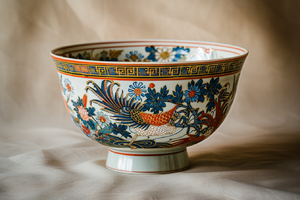Ko-Imari/jv: Difference between revisions
Created page with "Ko-Imari" |
Created page with "== Ekspor lan Resepsi Eropa ==" |
||
| Line 23: | Line 23: | ||
Ko-Imari ware ora dimaksudake mung kanggo panggunaan domestik. Akeh potongan sing disesuaikan karo selera Eropa, kalebu piring gedhe, vas, lan garniture kanggo dipamerake. | Ko-Imari ware ora dimaksudake mung kanggo panggunaan domestik. Akeh potongan sing disesuaikan karo selera Eropa, kalebu piring gedhe, vas, lan garniture kanggo dipamerake. | ||
< | <span id="Export_and_European_Reception"></span> | ||
== | == Ekspor lan Resepsi Eropa == | ||
<div lang="en" dir="ltr" class="mw-content-ltr"> | <div lang="en" dir="ltr" class="mw-content-ltr"> | ||
Revision as of 04:45, 18 July 2025
Ko-Imari

Ko-Imari (secara harfiah Imari Lawas) nuduhake gaya paling wiwitan lan paling apik saka barang Imari Jepang sing diprodhuksi utamane ing abad kaping 17. Porselen iki digawe ing kutha Arita lan diekspor saka pelabuhan cedhak Imari, sing menehi jeneng barang kasebut. Ko-Imari utamané misuwur kanggo gaya dekoratif dinamis lan pinunjul sajarah ing awal perdagangan porselen global.
Latar Belakang Sejarah
Ko-Imari ware muncul ing awal jaman Edo, watara taun 1640-an, sawisé ditemokaké lempung porselen ing wilayah Arita. Dipengaruhi wiwitan dening porselen biru-putih Cina, tukang tembikar Jepang wiwit ngembangake identitas gayane dhewe. Nalika ekspor porselen China mudhun amarga tibane Dinasti Ming, porselen Jepang wiwit ngisi celah ing pasar internasional, utamane liwat perdagangan karo Perusahaan Hindia Timur Walanda.
Fitur Utama
Kualitas khas Ko-Imari kalebu:
- Desain kandel lan warni, biasane nggabungake underglaze biru kobalt karo enamel overglaze kanthi warna abang, ijo, lan emas.
- Hiasan sing padhet lan simetris nutupi meh kabeh permukaan, asring diterangake minangka hiasan utawa malah mewah.
- Motif kayata krisan, peony, phoenix, naga, lan ombak utawa awan sing digayakake.
- Badan porselen kandel dibandhingake mengko, potongan luwih olahan.
Ko-Imari ware ora dimaksudake mung kanggo panggunaan domestik. Akeh potongan sing disesuaikan karo selera Eropa, kalebu piring gedhe, vas, lan garniture kanggo dipamerake.
Ekspor lan Resepsi Eropa
Ko-Imari ware was exported in large quantities throughout the 17th and early 18th centuries. It became a fashionable luxury item among European elites. In palaces and aristocratic homes across Europe, Ko-Imari porcelain adorned mantelpieces, cabinets, and tables. European porcelain manufacturers, particularly in Meissen and Chantilly, began producing their own versions inspired by Ko-Imari designs.
Evolution and Transition
By the early 18th century, the style of Imari ware began to evolve. Japanese potters developed more refined techniques, and new styles such as Nabeshima ware emerged, focusing on elegance and restraint. The term Ko-Imari is now used to specifically distinguish these early exported works from later domestic or revival pieces.
Legacy
Ko-Imari remains highly valued by collectors and museums worldwide. It is considered a symbol of Japan’s early contribution to global ceramics and a masterwork of Edo-period craftsmanship. The vivid designs and technical achievements of Ko-Imari continue to inspire both traditional and contemporary Japanese ceramic artists.
Relationship to Imari Ware
While all Ko-Imari ware is part of the broader category of Imari ware, not all Imari ware is considered Ko-Imari. The distinction lies primarily in the age, style, and purpose. Ko-Imari specifically refers to the earliest period, characterized by its dynamic energy, export orientation, and richly decorated surfaces.
